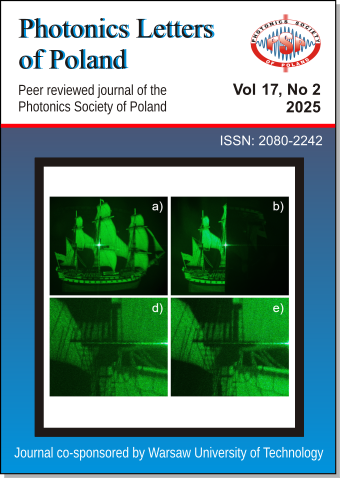A Deep Learning Driven Volatile Organic Compounds Analysis for Lung Cancer Detection Using HC-PCF and Convolutional Neural Networks
DOI:
https://doi.org/10.4302/plp.v17i2.1341Abstract
A Volatile Organic Compounds (VOC) detection system for lung cancer diagnosis through deep learning (DL) technology is implemented in a special Hollow-Core Photonic Crystal Fibre (HC-PCF) sensor platform. COMSOL Multiphysics is used to simulate the HC-PCF. A hexagonal lattice structure of silica material with 1 μm pitch dimensions and 0.5 μm air hole diameters allow for exceptional light guidance and VOC interaction when detecting exhaled breath components. The sensor achieves a remarkable refractive index sensitivity of 920 nm/RIU for detecting cancerous and non-cancerous VOC profiles. The refractive index measurements of lung cancer-related VOC samples fell within 1.380 to 1.392, while VOC samples from healthy patients ranged from 1.350 to 1.360. Sensor spectral response data processing relied on a Convolutional Neural Network (CNN) model that was trained to distinguish different VOC signature patterns. When applied to a dataset of 1,200 breath samples consisting of 600 cancer-positive and 600 healthy specimens, the CNN architecture reached a 96.3% overall classification accuracy combined with 94.7% sensitivity and 97.8% specificity.
Full Text: PDF
References
- S. Sharma, L. Tharani, "Photonic Crystal Fiber Sensor Design for Enhanced Tumor Detection: Structural Optimization and Sensitivity Analysis", Photonics Lett. Poland 16(2), 25 (2024). CrossRef
- A. Yasli, "Cancer Detection with Surface Plasmon Resonance-Based Photonic Crystal Fiber Biosensor", Plasmonics 16, 1605 (2021). CrossRef
- S. Sharma, S. Das, C.S. Shieh et al. "Design and Numerical Analysis of a Gold-Coated Photonic Crystal Fiber Sensor for Metabolic Disorder Detection with Deep Learning Assistance", Plasmonics (2025). CrossRef
- N. Ayyanar, G.T. Raja, M. Sharma, D.S. Kumar, "Photonic Crystal Fiber-Based Refractive Index Sensor for Early Detection of Cancer", IEEE Sensors Journal 18(17), 7093 (2018). CrossRef
- S. Sharma, L. Tharani, "Photonics for AI and AI for photonics integration : Materials and characteristics", J. Information and Optimization Sciences 45(3), 805 (2024). CrossRef
- M. Babińska, A. Władziński, "Enhanced Sensitivity of Absorption Spectroscopy Glucose Detection by Machine Learning", Photonics Lett. Poland 17(1), 16 (2025). CrossRef
- M. Babińska, A. Władziński, T. Talaśka, M. Szczerska, "Machine Learning Enhanced Optical Fiber Sensor For Detection Of Glucose Low Concentration In Samples Mimicking Tissue", Photonics Lett. Poland 17(1), 20 (2025). CrossRef
Downloads
Published
How to Cite
Issue
Section
License
Copyright (c) 2025 Jaitesh Upadhyay, Dr. Shobi Bagga, Dr. Dhirendra Mathur

This work is licensed under a Creative Commons Attribution 4.0 International License.
Authors retain copyright and grant the journal right of first publication with the work simultaneously licensed under a Creative Commons Attribution License that allows others to share the work with an acknowledgement of the work's authorship and initial publication in this journal. Authors are able to enter into separate, additional contractual arrangements for the non-exclusive distribution of the journal's published version of the work (e.g., post it to an institutional repository or publish it in a book), with an acknowledgement of its initial publication in this journal. Authors are permitted and encouraged to post their work online (e.g., in institutional repositories or on their website) prior to and during the submission process, as it can lead to productive exchanges, as well as earlier and greater citation of published work (See The Effect of Open Access).




